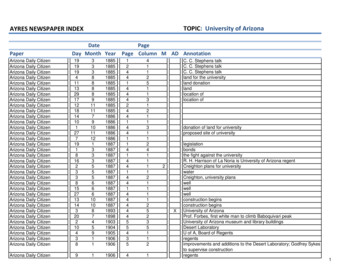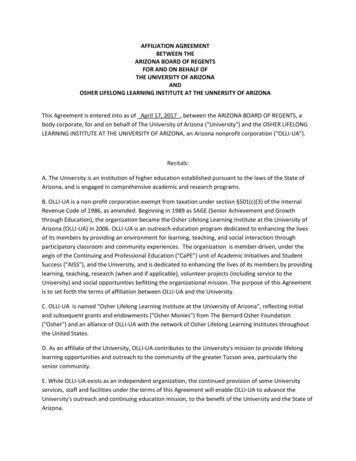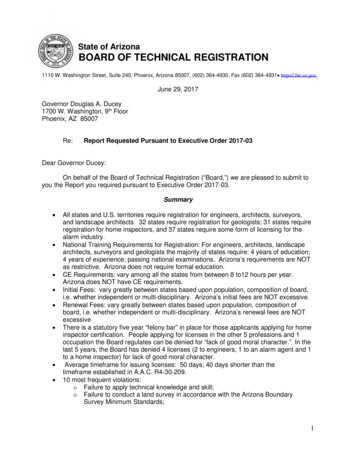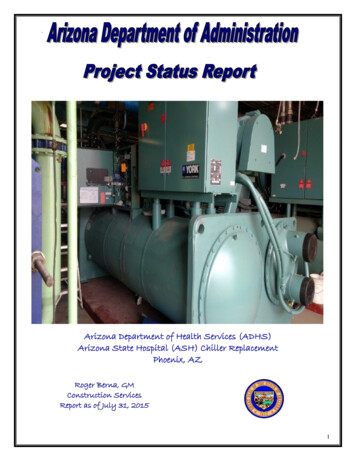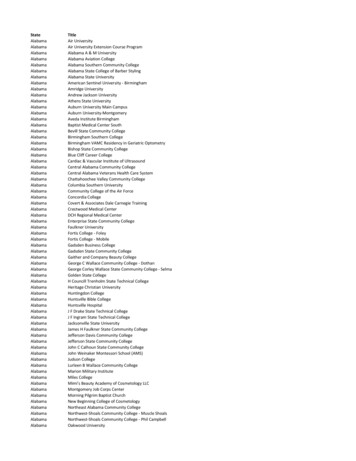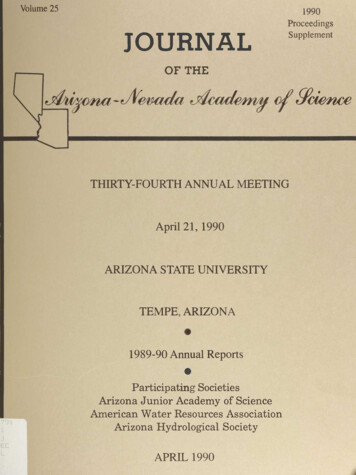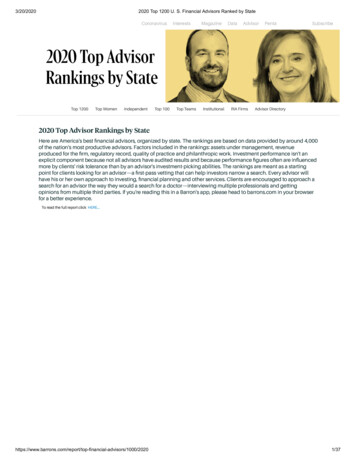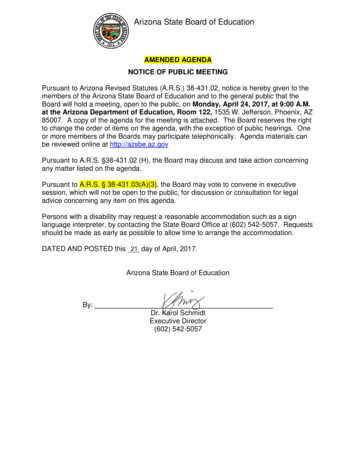
Transcription
Arizona State Board of EducationAMENDED AGENDANOTICE OF PUBLIC MEETINGPursuant to Arizona Revised Statutes (A.R.S.) 38-431.02, notice is hereby given to themembers of the Arizona State Board of Education and to the general public that theBoard will hold a meeting, open to the public, on Monday, April 24, 2017, at 9:00 A.M.at the Arizona Department of Education, Room 122, 1535 W. Jefferson, Phoenix, AZ85007. A copy of the agenda for the meeting is attached. The Board reserves the rightto change the order of items on the agenda, with the exception of public hearings. Oneor more members of the Boards may participate telephonically. Agenda materials canbe reviewed online at http://azsbe.az.govPursuant to A.R.S. §38-431.02 (H), the Board may discuss and take action concerningany matter listed on the agenda.Pursuant to A.R.S. § 38-431.03(A)(3), the Board may vote to convene in executivesession, which will not be open to the public, for discussion or consultation for legaladvice concerning any item on this agenda.Persons with a disability may request a reasonable accommodation such as a signlanguage interpreter, by contacting the State Board Office at (602) 542-5057. Requestsshould be made as early as possible to allow time to arrange the accommodation.21 day of April, 2017.DATED AND POSTED thisArizona State Board of EducationBy:Dr. Karol SchmidtExecutive Director(602) 542-5057
AMENDED AGENDAARIZONA STATE BOARD OF EDUCATIONApril 24, 2017Page 2Monday, April 24, 20179:00 AMArizona Department of Education, Room 1221535 W. Jefferson, Phoenix, AZ 850079:00 a.m.CALL TO ORDER, PLEDGE OF ALLEGIANCE, NATIONAL ANTHEM,PRAYER AND ROLL CALL1. BUSINESS REPORTS: The Board may discuss and take actionconcerning any matters listed on the agenda for Business Reports.A. President’s Report1. Updated priorities for 20172. Selection of SBE representative for WestEd Board ofDirectors3. Update on dyslexia policiesB. Superintendent’s Report1. 2017 Milken Educator for Arizona – Timothy Thomas,Principal at Rogers Ranch School in LaveenElementary School District2. Counselor of the Year – Tracey Pressley, LakeHavasu High School3. Update regarding Department activitiesC. Board Member Reports1. Update regarding Speak Up, Be Safe and Childhelp2. Update regarding K-12 computer science educationD. Executive Director’s Report1. Update on NASBE activities2. Update on the Menu of Assessments2. CONSENT AGENDA: All items on this Consent Agenda will beconsidered by a single motion with no discussion, unless an item isremoved and discussed as a regular agenda item upon the request ofany Board member.A. Approval of the revised Structured English Immersion (SEI)curricular framework for SEI endorsements
AMENDED AGENDAARIZONA STATE BOARD OF EDUCATIONApril 24, 2017Page 3B. Approval of the capital transportation adjustments for the purchaseof transportation vehicles pursuant to A.R.S. §15-963C. Approval of the extension of the Arizona Carl D. Perkins State Planand Funding for fiscal year 2018D. Approval of the following special education educator preparationprograms leading to Arizona educator certification:1. Pima Community College, Post BaccalaureateTeacher Certification Program, Mild to Moderate2. University of Phoenix, Alternative Pathway, Mild toModerateE. Approval of the following elementary education educatorpreparation programs leading to Arizona educator certification:1. University of Phoenix, Master of Arts in Education,Elementary Education2. Scottsdale Community College, Scottsdale TeacherEducation Partnership (STEP), Elementary EducationF. Approval of the following secondary education educator preparationprograms leading to Arizona educator certification:1. Prescott College, Bachelor’s Degree, SecondaryEducation2. Prescott College, Post-Baccalaureate Degree,Secondary Education3. Prescott College, Master’s Degree, SecondaryEducation4. University of Arizona South, Masters of Education(M.Ed.), Secondary EducationG. Approval of additional monies for Teacher Compensation for thefiscal year 2017-2018H. Approval to authorize the Arizona Department of Education (ADE)to enter into an agreement with the United States Department ofAgriculture (USDA) to receive and expend a National Farm toSchool Network grant from the TIDE CenterI. Approval of school district applications for the Arizona On-LineInstruction Program, pursuant to A.R.S. § 15-808:1. Amphitheater Unified School District - K-12
AMENDED AGENDAARIZONA STATE BOARD OF EDUCATIONApril 24, 2017Page 42. Blue Ridge Unified School District - 9-12J. Acceptance of the resignation of M. Diane Bruening from theSpecial Education Advisory Panel3. CALL TO THE PUBLIC: This is the time for the public to comment.Members of the Board may not discuss items that are not specificallyidentified on the agenda. Therefore, pursuant to A.R.S. 38-431.01(H),action taken as a result of public comment will be limited to directingstaff to study the matter, responding to any criticism or scheduling thematter for further consideration and decision at a later date.4. GENERAL SESSIONA. Presentation and discussion regarding legislative affairs. TheBoard may take action to support, oppose or remain neutral onspecific legislative proposals.B. Presentation, discussion and action regarding the A-F SchoolAccountability Plan for 2016-2017BB. Presentation and discussion of ESSA Long-Term Goals andMeasures of Interim ProgressC. Presentation and discussion on rulemaking procedures for Boardrules R7-2-300 and R7-2-302 regarding minimum course of studyfor common schools and high schoolsD. Presentation, discussion and possible action to initiate rulemakingprocedures for the proposed Board rule R7-2-318 regarding the K-3Reading Program5. CONSENT AGENDA – CERTIFICATION ENFORCEMENT ACTIONS:All items on this Consent Agenda will be considered by a single motionwith no discussion, unless an item is removed and discussed as aregular agenda item upon the request of any Board member.A. Approval of the voluntary surrender of the educator certificates heldby:1. Geoffrey Begaye2. Adam Chrestman3. Katelyn Elms4. Theodore Finkbeiner5. Alexis Gonzalez6. Joel Gordon7. Molly McNamara
AMENDED AGENDAARIZONA STATE BOARD OF EDUCATIONApril 24, 2017Page 58. Rogelio Villa Ramirez9. Charles SchubertB. Approval of the permanent revocation of any and all educatorcertificates, pursuant to A.R.S. § 15-550, held by William RegisWall Jr.6. GENERAL SESSION – CERTIFICATION ENFORCEMENT ACTIONSA. Presentation, discussion and possible action to approve theNegotiated Settlement Agreements for:1.2.3.4.Jeffrey CantoJorge CastilloPatrick O’BoyleDesiree TimecheB. Presentation, discussion and possible action on the findings of fact,conclusions of law and recommendations of the ProfessionalPractices Advisory Committee to approve the applications forcertification of:1.2.3.4.Lesley Ann BelanWilliam CastleMarian Carr DawleyTerrance GeneehaC. Presentation, discussion and possible action on the findings of fact,conclusions of law and recommendation of the ProfessionalPractices Advisory Committee to approve the suspension of thecertificate held by Imelda GarciaD. Presentation, discussion and possible action on the findings of fact,conclusions of law and recommendation of the ProfessionalPractices Advisory Committee to approve the revocations ofcertificates held by:1. Cardenas Redsteer2. Eddie Rodriquez3. Liliya Souslova7. SUMMARY OF CURRENT EVENTS, FUTURE MEETING DATESAND ITEMS FOR FUTURE AGENDAS. The executive director,presiding officer or a member of the Board may present a briefsummary of current events pursuant to A.R.S. § 38-431.02(K), andmay discuss future meeting dates and direct staff to place matters on a
AMENDED AGENDAARIZONA STATE BOARD OF EDUCATIONApril 24, 2017Page 6future agenda. The Board will not discuss or take action on anycurrent event summary.
EXECUTIVE SUMMARYIssue:Arizona State Board of Education MeetingApril 24, 2017Item #2APage 1 of 1SEI Curricular Framework RevisionAction/Discussion ItemInformation ItemBackground and DiscussionAll teachers in SEI Classrooms must have a Structured English Immersion endorsement(Provisional endorsement or full endorsement) (SBE Rules, R7-2-613.J), an English asa Second Language endorsement (Provisional endorsement or full endorsement) (SBERules, R7-2-613.I), or a Bilingual endorsement (Provisional endorsement or fullendorsement) (SBE Rules, R7-2-613.H).The Structured English Immersion (SEI) curricular framework, which outlines therequirements of coursework leading to the SEI endorsement, was approved by theState Board in 2005 and has not been updated or reviewed since that time. Manychanges have occurred in the last 12 years to impact the relevance of this framework,including the adoption of the SEI model and changes to the requirements for teachercertification. The Office of English Language Acquisition Services has worked withEnglish language learner practitioners, representatives from higher education andstakeholders to develop a revised SEI curricular framework.Recommendation to the BoardIt is recommended that the Board adopt the revised SEI curricular framework.Contact Information:Kate Wright, Deputy Associate Superintendent, OELAS, Migrant, HomelessCarol Lippert, Associate Superintendent, High Academic Standards
SEI Course Frame Works RevisionSEI FoundationsLegal and Historical Foundations (2 hours) Explain how the following legal cases impacted the policies and laws governing language instruction in Arizona: Lau v. Nichols,Castaneda v. Pickard, Flores v. Arizona, and Plyler v. Doe.Explain how federal laws and requirements, including the Every Student Succeeds Acts (ESSA), Title III, Title VI, and Office forCivil Rights/Department of Justice resolutions, impact accountability, assessment, funding, and identification in EL educationin Arizona.Explain how state laws and policies, including Proposition 203, House Bill 2010, House Bill 2064, and Move On When Reading(for elementary only) impact language acquisition methodology, student grouping, and the time frame to achieve languageproficiency.Explain the demographic composition of the PK -12 EL population in Arizona.Discuss the current societal trends and issues in the education of ELs.Structured English Immersion (3 hours)Terminology Used in Arizona Define English Learner (EL). Define SEI as it is used in Arizona, including the distinctions between Structured English Immersion and Sheltered EnglishInstruction. Define English Language Development (ELD) and its relevance to the instruction of ELs in Arizona.Identification and Assessment Explain the process used to determine EL program eligibility including the use of the Home Language Survey and Arizona’sEnglish language proficiency assessment. Differentiate the uses of Arizona’s English language proficiency assessment for placement and reassessment. Identify the standard accommodations available to ELs for assessment. Recognize that students may qualify for other services (ESS, Gifted) in addition to being identified as an EL.Models/Structure Discuss the differences between Structured English Immersion classrooms, Bilingual classrooms, and Individual LanguageLearner Plans. Discuss components of EL program models in Arizona including time allocations, grouping, use of native language, integrationof content, and SEI Model refinements.English Language Proficiency (ELP) Standards Explain the development of the ELP Standards, the alignment of the ELP Standards to English Language Arts Standards, andconnections to other academic content. Explore the format of the ELP Standards with respect to Stages, Proficiency Level Descriptors, Standards, Concepts, SubConcepts, Proficiency Levels, Performance Indicators, and the Glossary.Language DevelopmentLanguage Acquisition Theories (3 hours) Explain current and historical theories of language acquisition as they apply to English learners (Behaviorist Theory, NativistTheory, Social Interactionist Theory, Cognitive Theory, etc.).Elements of Language (6 hours) Define each element of language: phonetics, phonology, morphology, lexicon, semantics, syntax, and pragmatics. Describe relationships between the elements of language within verbal and written expressions.Page 1 of 6April 4, 2017
Language Domains (6 hours) Examine a Stage of the ELP Standards to determine connections between the elements of language and Reading, Writing,Vocabulary, Standard English Conventions (Grammar), and Listening and Speaking Discuss how the skills found in ELP Standards apply to other content areas.Instructional Elements (Elementary Only)Instructional Strategies for Academic English Development (13 hours)Universal Design for Learning Define elements of engagement (why), representation (what), and action and expression (how), and describe how they allowteachers to consider the learning needs of all students when planning lessons.Reading Instruction Aligned with the ELP Standards Explore foundational reading skills as they apply to elementary ELs.Explore reading comprehension skills as they apply to elementary ELs.Explore reading strategies that help elementary ELs access grade level content area text.Explore the development of a lesson aligned to the Reading Domain of the ELP Standards that includes the use of grade levelappropriate materials.Writing Instruction Aligned with the ELP Standards Explore foundational writing skills as they apply to elementary ELs.Explore writing application skills as they apply to elementary ELs.Explore writing strategies that help elementary ELs to develop written language complexity.Explore the development of a lesson aligned to the Writing Domain of the ELP Standards that includes the use of grade levelappropriate materials.Listening and Speaking Instruction Aligned with the ELP Standards Explore receptive oral language skills as they apply to elementary ELs.Explore productive oral language skills as they apply to elementary ELs.Explore receptive and productive strategies that help elementary ELs to engage in academic discourse.Explore the development of a lesson aligned to the Listening and Speaking Domain of the ELP Standards that includes the useof grade level appropriate materials.Grammar Instruction Aligned with the ELP Standards Explore grammatical skills as a foundation of language for elementary ELs. Explore the development of a lesson aligned to the Language Strand of the ELP Standards that includes the use of grade levelappropriate materials.Explore strategies that allow elementary ELs to apply their knowledge of syntax to create and understand communication invarious contexts.Vocabulary Instruction Aligned with the ELP standards Explore word study skills as they apply to elementary ELs.Explore strategies that help elementary ELs to utilize academic vocabulary in multiple contexts.Explore the development of a lesson aligned to the Language Strand of the ELP Standards that includes the use of grade levelappropriate materials.Differentiation (3 hours) Consider the needs (language level, skill, etc.) of learners that would require differentiation of instruction. Explore appropriate strategies to differentiate instruction based on the needs of learners.Page 2 of 6April 4, 2017
Assessment (3 hours) Differentiate between types of assessments (e.g., diagnostic, formative, and summative). Review models of data collection used to document progress in language development. Analyze various forms of assessment data to make instructional decisions for ELs.Diversity of ELs (2 hours) Explain who long term ELs (LTEL) are and various factors influencing their English language acquisition. Explain who Recent Arrivals (RAEL) are and various factors influencing their language acquisition. Explain who Students with Interrupted Formal Education (SIFE) are and various factors influencing their language acquisition. Discuss special populations (Refugee, Migrant, Immigrant, and Native American) of ELs as relevant to LTEL, RAEL, and SIFEsubgroups.Culturally Relevant Instruction (4 hours)Cultural Influences on Teaching and Learning Define cultural competence and explain its role in the instruction of ELs.Describe the role of culture in student learning.Explore strategies for supporting cultural diversity within instruction.Describe the appropriate selection of curriculum, materials, and assessments for all language learners, accounting forproficiency, age, and heritage.Inclusive Environment Describe how school and classroom environment influences language acquisition and the steps necessary to create aninclusive environment. Discuss the importance of understanding the social, emotional, and cultural needs of students when establishing classroomroutines and procedures.Home and School Connections Describe how family and community practices (funds of knowledge) may influence language learning. Describe inclusive community engagement practices.Describe effective family engagement practices including communication, family involvement, and providing intentionalstrategies for families of ELs.Explore the development of a lesson aligned to the Writing Domain of the ELP Standards that includes the use of grade levelappropriate materials.Listening and Speaking Instruction Aligned with the ELP Standards Explore receptive oral language skills as they apply to secondary ELs.Explore productive oral language skills as they apply to secondary ELs.Explore receptive and productive strategies that help secondary ELs to engage in academic discourse.Explore the development of a lesson aligned to the Listening and Speaking Domain of the ELP Standards that includes the useof grade level appropriate materials.Grammar Instruction Aligned with the ELP Standards Explore grammatical skills as a foundation for secondary ELs. Explore the development of a lesson aligned to the Language Strand of the ELP Standards that includes the use of grade levelappropriate materials.Explore strategies that allow secondary ELs to apply their knowledge of syntax to create and understand communication invarious contexts.Vocabulary Instruction Aligned with the ELP standards Explore word study skills as they apply to secondary ELs.Explore strategies that help secondary ELs to utilize academic vocabulary in multiple contexts.Page 3 of 6April 4, 2017
Explore the development of a lesson aligned to the Language Strand of the ELP Standards that includes the use of grade levelappropriate materials.Differentiation (3 hours) Consider the needs (language level, skill, etc.) of learners that would require differentiation of instruction. Explore appropriate strategies to differentiate instruction based on the needs of learners. Explore balancing language and content needs with age-appropriate instruction.Assessment (3 hours) Differentiate between types of assessments (diagnostic, formative, and summative). Review models of data collection in order to document progress in language development. Analyze assessment data to make instructional decisions.Diversity of ELs (2 hours) Explain who long term ELs (LTEL) are and various factors influencing their English language acquisition. Explain who Recent Arrivals (RAEL) are and various factors influencing their language acquisition. Explain who Students with Interrupted Formal Education (SIFE) are and various factors influencing their language acquisition. Discuss special populations (Refugee, Migrant, Immigrant, and Native American) of EL as relevant to LTEL, RAEL, and SIFEsubgroups. Discuss additional considerations needed for secondary ELs as relevant to LTEL, RAEL, and SIFE subgroups.Culturally Relevant Instruction (4 hours)Cultural Influences on Teaching and Learning Define cultural competence and explain its role in teaching ELs.Describe the role of culture in student learning.Explore strategies for supporting cultural diversity within instruction.Describe the appropriate selection of curriculum, materials, and assessments for secondary language learners, accounting forproficiency, age, and heritage.Inclusive Environment Describe how school/classroom environment influences language acquisition and the steps necessary to create an inclusiveenvironment. Discuss the social, emotional, and cultural needs of students when establishing classroom routines and procedures.Home and School Connections Describe how family and community practices (funds of knowledge) may influence language learning. Describe inclusive community engagement practices.Describe effective family engagement practices, including communication, family involvement, and providing intentionalstrategies for families of ELs.Instructional Elements (Secondary Only)Instructional Strategies for Academic English Development (13 hours)Universal Design for Learning Define elements of engagement (why), representation (what), and action and expression (how), and describe how they allowteachers to consider the learning needs of all students when planning lessons.Page 4 of 6April 4, 2017
Reading Instruction Aligned with the ELP Standards Explore foundational reading skills as they apply to secondary ELs.Explore reading comprehension skills as they apply to secondary ELs.Explore reading strategies that help secondary ELs access grade level content area text.Explore the development of a lesson aligned to the Reading Domain of the ELP Standards that includes the use of grade levelappropriate materials.Writing Instruction Aligned with the ELP Standards Explore foundational writing skills as they apply to secondary ELs.Explore writing application skills as they apply to secondary ELs.Explore writing strategies that help secondary ELs to develop written language complexity.Explore the development of a lesson aligned to the Writing Domain of the ELP Standards that includes the use of grade levelappropriate materials.Listening and Speaking Instruction Aligned with the ELP Standards Explore receptive oral language skills as they apply to secondary ELs.Explore productive oral language skills as they apply to secondary ELs.Explore receptive and productive strategies that help secondary ELs to engage in academic discourse.Explore the development of a lesson aligned to the Listening and Speaking Domain of the ELP Standards that includes the useof grade level appropriate materials.Grammar Instruction Aligned with the ELP Standards Explore grammatical skills as a foundation of language for secondary ELs. Explore the development of a lesson aligned to the Language Strand of the ELP Standards that includes the use of grade levelappropriate materials.Explore strategies that allow secondary ELs to apply their knowledge of syntax to create and understand communication invarious contexts.Vocabulary Instruction Aligned with the ELP standards Explore word study skills as they apply to secondary ELs.Explore strategies that help secondary ELs to utilize academic vocabulary in multiple contexts.Explore the development of a lesson aligned to the Language Strand of the ELP Standards that includes the use of grade levelappropriate materials.Differentiation (3 hours) Consider the needs (language level, skill, etc.) of learners that would require differentiation of instruction. Explore appropriate strategies to differentiate instruction based on the needs of learners. Explore balancing language and content needs with age-appropriate instruction.Assessment (3 hours) Differentiate between types of assessments (e.g., diagnostic, formative, and summative). Review models of data collection used to document progress in language development. Analyze various forms of assessment data to make instructional decisions for ELs.Diversity of ELs (2 hours) Explain who long term ELs (LTEL) are and various factors influencing their English language acquisition. Explain who Recent Arrivals (RAEL) are and various factors influencing their language acquisition. Explain who Students with Interrupted Formal Education (SIFE) are and various factors influencing their language acquisition. Discuss special populations (Refugee, Migrant, Immigrant, and Native American) of EL as relevant to LTEL, RAEL, and SIFEsubgroups. Discuss additional considerations needed for secondary ELs as relevant to LTEL, RAEL, and SIFE subgroups.Page 5 of 6April 4, 2017
Culturally Relevant Instruction (4 hours)Cultural Influences on Teaching and Learning Define cultural competence and explain its role in the instruction of ELs.Describe the role of culture in student learning.Explore strategies for supporting cultural diversity within instruction.Describe the appropriate selection of curriculum, materials, and assessments for secondary language learners, accounting forproficiency, age, and heritage.Inclusive Environment Describe how school and classroom environments influence language acquisition and the steps necessary to create aninclusive environment. Discuss the importance of understanding the social, emotional, and cultural needs of students when establishing classroomroutines and procedures.Home and School Connections Describe how family and community practices (funds of knowledge) may influence language learning. Describe inclusive community engagement practices.Describe effective family engagement practices including communication, family involvement, and providing intentionalstrategies for families of ELs.Page 6 of 6April 4, 2017
SEI Course Frame Works Revision – ElementarySEI FoundationsLegal and Historical Foundations (2 hours) Explain how the following legal cases impacted the policies and laws governing language instruction in Arizona: Lau v. Nichols,Castaneda v. Pickard, Flores v. Arizona, and Plyler v. Doe.Explain how federal laws and requirements, including the Every Student Succeeds Acts (ESSA), Title III, Title VI, and Office forCivil Rights/Department of Justice resolutions, impact accountability, assessment, funding, and identification in EL educationin Arizona.Explain how state laws and policies, including Proposition 203, House Bill 2010, House Bill 2064, and Move On When Readingimpact language acquisition methodology, student grouping, and the time frame to achieve language proficiency.Explain the demographic composition of the PK -12 EL population in Arizona.Discuss the current societal trends and issues in the education of ELs.Structured English Immersion (3 hours)Terminology Used in Arizona Define English Learner (EL). Define SEI as it is used in Arizona including the distinctions between Structured English Immersion and Sheltered EnglishInstruction. Define English Language Development (ELD) and its relevance to the instruction of ELs in Arizona.Identification and Assessment Explain the process used to determine EL program eligibility including the use of the Home Language Survey and Arizona’sEnglish language proficiency assessment. Differentiate the uses of Arizona’s English language proficiency assessment for placement and reassessment. Identify the standard accommodations available to ELs for assessment. Recognize that students may qualify for other services (ESS, Gifted) in addition to being identified as an EL.Models and Structure Discuss the differences between Structured English Immersion classrooms, Bilingual classrooms, and Individual LanguageLearner Plans. Discuss components of EL program models in Arizona including time allocations, grouping, use of native language, integrationof content, and SEI Model refinements.English Language Proficiency (ELP) Standards Explain the development of the ELP Standards, the alignment of the ELP Standards to the English Language Arts Standards,and connections to other academic content. Explore the format of the ELP Standards with respect to Stages, Proficiency Level Descriptors, Standards, Concepts, SubConcepts, Proficiency Levels, Performance Indicators, and the Glossary.Language DevelopmentLanguage Acquisition Theories (3 hours) Explain current and historical theories of language acquisition as they apply to ELs (Behaviorist Theory, Nativist Theory, SocialInteractionist Theory, Cognitive Theory, etc.).Elements of Language (6 hours) Define each element of language: phonetics, phonology, morphology, lexicon, semantics, syntax, and pragmatics. Describe relationships between the elements of language within verbal and written expressions.Page 1 of 3 April 4, 2017
Language Domains (6 hours) Examine a Stage of the ELP Standards to determine connections between the elements of language and Reading, Writing,Vocabulary, Standard English Conventions (Grammar), and Listening and Speaking.Instructional ElementsInstructional Strategies for Academic English Development (13 hours)Universal Design for Learning Define elements of engagement (why), representation (what), and action and expression (how), and describe how they allowteachers to consider the learning needs of all students when planning lessons.Reading Instruction Aligned with the ELP Standards Explore foundational reading skills as they apply to elementary ELs.Explore reading comprehension skills as they apply to elementary ELs.Explore reading strategies that help elementary ELs access grade level content area text.Explore the development of a lesson aligned to the Reading Domain of the ELP Standards that includes the use of grade levelappropriate materials.Writing Instruction Aligned with the ELP Standards Explore foundational writing skills as they apply to elementary ELs.Explore writing application skills as they apply to elementary ELs.Explore writing strategies that help elementary ELs to develop written language complexity.Explore the development of a lesson aligned to the Writing Domain of the ELP Standards that includes the use of grade levelappropriate materials.Listening and Speaking Instruction Aligned with the ELP Standards Explore receptive oral language skills as they apply to elementary ELs.Explore productive oral language skills as they apply to elementary ELs.Explore receptiv
Arizona State Board of Education AMENDED AGENDA NOTICE OF PUBLIC MEETING Pursuant to Arizona Revised Statutes (A.R.S.) 38-431.02, notice is hereby given to the . 4. University of Arizona South, Masters of Education (M.Ed.), Secondary Education . Kate Wright, Deputy Associate Superintendent, OELAS, Migrant, Homeless .
